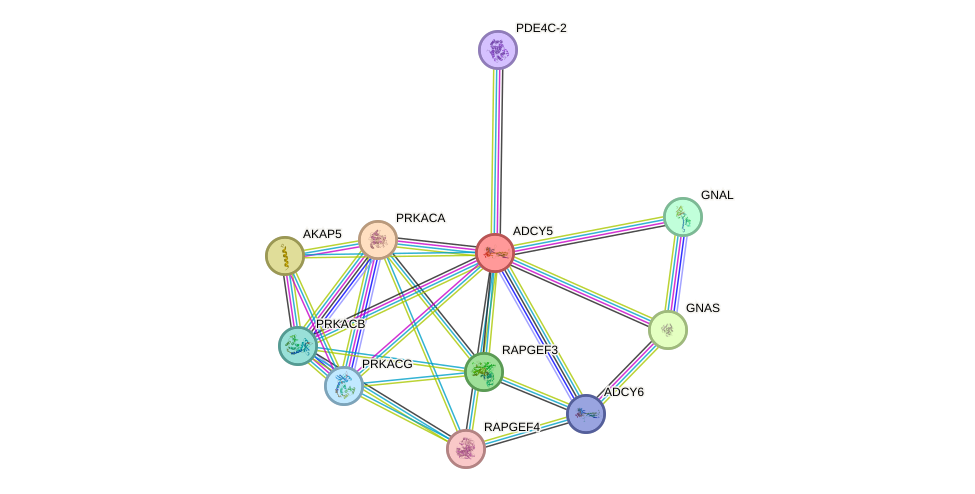GenAge entry for ADCY5 (Homo sapiens)
Entry selected based on evidence directly linking the gene product to ageing in a mammalian model organism
Gene name (HAGRID: 255)
- HGNC symbol
- ADCY5
- Aliases
- AC5
- Common name
- adenylate cyclase 5
Potential relevance to the human ageing process
- Main reason for selection
- Entry selected based on evidence directly linking the gene product to ageing in a mammalian model organism
- Description
ADCY5 belongs to the family of enzymes responsible for the synthesis of cAMP. ADCY5 activity is an important physiological mechanism for mediating enhanced exercise performance [4342]. ADCY5 appears to have some impact on murine ageing and possibly on human ageing.
Knockout mice are protected from ageing-induced cardiomyopathy and susceptibility to fractures of ageing, and have an increased median lifespan of approximately 30%. Cells from these animals are also more resistant to oxidative stress [1845]. Moreover, knockout mice eat more but weight less and accumulate less fat compared to wild-type. Putting mice under caloric restriction results in weight loss, metabolic deterioration and premature death. While pathological mechanisms cannot be excluded, these results suggest Adcy5 may be involved in caloric restriction [3290]. In keeping with its role in exercise performance transgenic overexpression of ADCY5 in cardiomyocytes of the heart (AC5-Tg) improves baseline cardiac function but impairs the ability of the heart to withstand stress [3581]. In contradiction to this ADCY5 knockout mice have also been shown to have enhanced exercise performance, though this effect was found to be limited to skeletal muscle. In relation to its role in longevity, exercise performance was also improved in ADCY5 knock-out mice. This effect was blocked when SIRT1, MEK or SOD2 inhibitors were used [4342]. Additionally, ADCY5 knockout delays age-related tumor incidence significantly and protects against mammary tumor development in AC5KO × MMTV-HER-2 neu mice, and B16F10 melanoma tumor growth [3580], which could explain why AC5KO is a model of longevity.
Cytogenetic information
- Cytogenetic band
- 3q21.1
- Location
- 123,282,296 bp to 123,448,545 bp
- Orientation
- Minus strand
Protein information
- Gene Ontology
-
Process: GO:0001973; adenosine receptor signaling pathway
GO:0003091; renal water homeostasis
GO:0006171; cAMP biosynthetic process
GO:0007189; adenylate cyclase-activating G-protein coupled receptor signaling pathway
GO:0007190; activation of adenylate cyclase activity
GO:0007191; adenylate cyclase-activating dopamine receptor signaling pathway
GO:0007193; adenylate cyclase-inhibiting G-protein coupled receptor signaling pathway
GO:0007195; adenylate cyclase-inhibiting dopamine receptor signaling pathway
GO:0007204; positive regulation of cytosolic calcium ion concentration
GO:0007626; locomotory behavior
GO:0019933; cAMP-mediated signaling
GO:0034199; activation of protein kinase A activity
GO:0050885; neuromuscular process controlling balance
GO:0061178; regulation of insulin secretion involved in cellular response to glucose stimulus
GO:0071377; cellular response to glucagon stimulus
GO:1904322; cellular response to forskolin
Cellular component: GO:0005622; intracellular
GO:0005886; plasma membrane
GO:0005929; cilium
GO:0016021; integral component of membrane
Hide GO termsFunction: GO:0004016; adenylate cyclase activity
GO:0005524; ATP binding
GO:0008179; adenylate cyclase binding
GO:0046872; metal ion binding
GO:0046982; protein heterodimerization activity
GO:0097110; scaffold protein binding
Protein interactions and network
Retrieve sequences for ADCY5
Homologs in model organisms
In other databases
- GenAge model organism genes
- A homolog of this gene for Mus musculus is present as Adcy5
- GenDR gene manipulations
- A homolog of this gene for Mus musculus is present as Adcy5
- LongevityMap
- This gene is present as ADCY5

